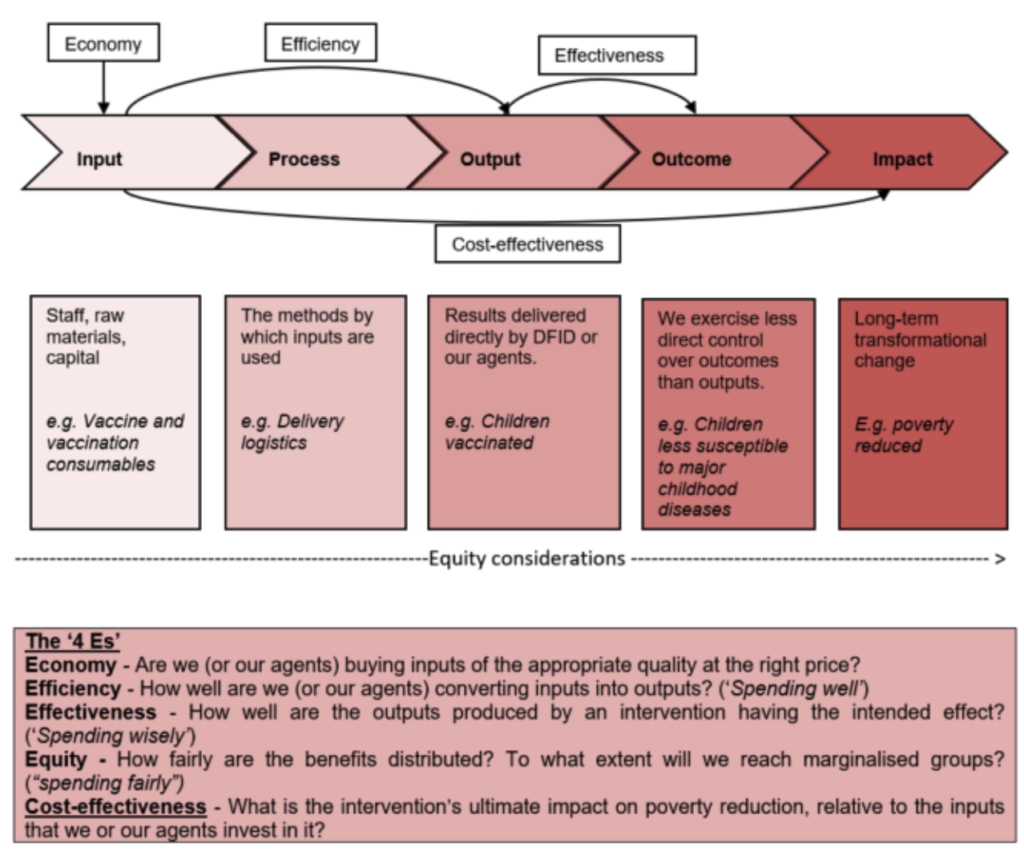
What is VfM?
The concept of Value for Money (VfM) was initially introduced in the international development sector by the UK Department for International Development (DFID), which defined it as the optimization of the impact achieved for each pound spent in order to improve people’s lives (DFID, 2011).
Value for Money (VfM) is a concept used to assess how well organizations optimize their costs and maximize their impact to achieve their goals. It helps organizations use their resources efficiently and strategically, which leads to better outcomes and increased effectiveness. There are different frameworks and approaches to assess VfM, and the choice of approach depends on the nature of the program, the context, and how monitoring, evaluation, and learning (MEL) is approached.
Value for money is a multifaceted concept that goes beyond simply measuring the cost-effectiveness of development interventions. It encompasses the efficiency, effectiveness, and sustainability of projects and programs, taking into account the long-term impact on the people they are aiming to target. The key considerations for value for money in international development include achieving meaningful outcomes, using resources efficiently, ensuring sustainability, and promoting accountability and transparency.
By periodically evaluating how much they are investing and what difference they are making with these funds, organizations can ensure that they are using their resources effectively. Value for money aids in finding innovative ways to use limited resources efficiently and strategically, enabling organizations to achieve the maximum impact with the resources available to them. It helps organizations prioritize their spending and ensure that they are making the most informed decisions when it comes to resource allocation, ultimately leading to better outcomes and increased effectiveness.
What frameworks and approaches are used to assess VfM?
Assessing value for money (VfM) can be approached through various frameworks and methodologies, there is no one-size-fits-all approach. The choice of approach depends on the nature of the program, the context, and how monitoring, evaluation, and learning (MEL) is approached.
Some examples of VfM frameworks and approaches we have successfully used and/or adapted include the following:
- The standard Value for Money 4Es framework, which entails identifying and tracking the indicators of economy, efficiency, effectiveness, and equity – and, where appropriate, cost effectiveness.
- The contextualized Value for Investment system developed by Julian King, which entails defining context-specific definions of the 4Es, including criteria and standards.
- Quantitative and monetary-based approaches and methodologies, including economic analysis, cost-efficiency and effectiveness analysis, cost-benefit analysis (CBA) and social returns on investment (SROI). These methods focus on monetising outcomes and benefits and relating them to the costs. They usually work best in programmes that generate tangible results that can be easily monetised or in service delivery interventions.
- The participatory approach to VfM, developed by ActionAid, emphasizes the active involvement and participation of stakeholders throughout the project or intervention. This approach ensures that the perspectives, needs, and priorities of stakeholders are considered and incorporated into the analysis of value for money. It involves stakeholders in the decision-making, planning, implementation, and analysis stages, and aims to enhance transparency, accountability, and ownership of the assessment process. This approach does not use the 4Es explicitly but rather assesses the value generated by the programme and its components and relates it to the investment, combining a series of methodologies and approaches such as Outcome Harvesting, Most Significant Change, Basic Efficiency Resource and Investment Analysis.
- Outcome Harvesting (OH) is a monitoring and evaluation methodology used to identify, describe, verify, and analyse the changes brought about through a development intervention. It is designed to collect evidence of change, and then work backwards to assess the contribution to that change (Outcome Harvesting).Using OH to assess VfM offers several benefits, including a clear understanding of the value generated and its extent, identification of unintended consequences, a less siloed approach than traditional VfM approaches (4Es), and the ability to generate learning on cross-cutting areas.
The Value for Money 4Es framework
The 4Es framework is commonly used to report on Value for Money (VfM), particularly to the UK FCDO and other donors. It assesses an organisation using the following criteria:
- Economy: focuses on demonstrating efforts to ensure that costs are reasonable considering the required quality of the goods and services to be procured.
- Efficiency: focuses on providing evidence that the implementation process is appropriate, allowing the program to deliver its outputs in the smoothest way possible.
- Effectiveness: focuses on providing evidence that the program is achieving results that are transformational and sustainable and that appropriate learning processes are in place to support this.
- Equity: focuses on providing evidence that specific measures have been put in place to address the priorities of the most vulnerable, apply gender-sensitive principles, and ensure clear targeting has been undertaken.

4Es
Source: UK Aid Direct
These criteria are used to assess various aspects of VfM, including cost-effectiveness, impact, sustainability, and equity considerations, to ensure that programs are being implemented efficiently and effectively, and are addressing the needs of the target population in an equitable manner.
The table below simplifies the definition of each E and provides some examples.
| E | Definition (ICAI) | Simplified Definition | Example for a hypothetical capacity building programme |
| Economy | Getting the best value inputs | HOW MUCH? The best price for the good and services procured | Were the inputs (venues, trainers, transport, etc.) for the capacity building of community purchased at the lowest possible cost, given the quality and quantity required? |
| Efficiency | Maximising the outputs for a given level of inputs | HOW? The process of delivery ensures that resources are optimized while reaching as many people as possible | How many people were able to access the capacity building? Did the programme work with local partners who already had presence in the communities (reducing our infrastructure and start-up costs)? |
| Effectiveness | Ensuring that the outputs deliver the desired outcome | WHAT? The changes that the programme is generating and their sustainability | What are the people that participated in the capacity building doing differently as a result of what they learnt? |
| Equity | Ensuring that the benefits are distributed fairly | WHO? The people that the programme is targeting, with special attention to the most vulnerable. | Have the most vulnerable (children, women, minority groups, people with disability) join the capacity building programme? What specific measures were put in place to ensure this? |
| Cost-effectiveness | Maximising the relationships between impact and costs | HOW DO THE COSTS COMPARE? How does the cost of achieving one outcome compare to the cost of achieving another one? | What was the cost of changing the attitude towards the issue addressed of one community leader? How does it compare to the costs of changing the attitude of one community teacher? |
Overall, across the sector, an initiative is considered VfM when it can achieve an optimal balance among the 4 or 5Es. It is often not possible to fully address all the Es simultaneously. As described by the UK Independent Commission for Aid Impact (ICAI), reaching remote areas, hard-to-reach groups (such as semi-nomadic herders in Uganda) or the marginalised within society (such as people with disabilities) often involves higher costs. For a given budget, there are trade-offs between reaching such groups and maximising the overall number of beneficiaries (ICAI).
The Value for Money 4Es framework in the Partnership Fund for a Resilient Ukraine (PFRU)
We recently supported the Partnership Fund for a Resilient Ukraine (PFRU), managed by Chemonics, to help them kick-off their thinking about what VfM may look like across their 3 components: Resistance, Recovery, and Revitalisation.
The programme was requested to provide evidence on the 4Es and so we helped them identify how they might do so, given the nature of the programme, their programmatic pillars and the challenges of the context where they operate. Taking into consideration that the programme operates in a context that is constantly changing and that it developed a monitoring, evaluation and learning (MEL) framework focussed on adaptive management and learning, the VfM approach was unlikely to be aligned to the standard formats.
To address this we delivered a series of workshops with the team to (a) get everybody on the same page in terms of what VfM means and what approaches and methodologies are available to assess it; (b) define what value may look like across the three programmatic components; and (c) contextualise the definitions of the 4Es within each component to unpack what they look like in practice.
The workshops enabled us to draw out some key aspects that the programme needs to take into account when developing its own VfM approach and methodologies.
The workshops held suggested that the 4Es framework is not always suitable for programmes like the PFRU. In fact, it can be quite restrictive given the programme’s nature, characteristics, and approach which do not follow a linear change pathway but rather are based on adaptation and change.
The PFRU’s three pillars are substantially different from each other and the 4Es do not seem to be suited to reflect the particularities of how each pillar intends to deliver or is delivering VfM. Other criteria linked to the specific goals of the PFRU may be more appropriate. For instance, VfM in the Early Recovery component may be associated to timeliness rather than on criteria linked to teach of the 4Es.
Conclusions
In conclusion, the Value for Money 4Es framework is usually used to report to donors on VfM by showcasing how a programme has been able to address the 4Es, providing evidence that can illustrate this.
However, VfM is about “continuous improvement” which entails identifying areas for improvement and developing strategies to further improve VfM, either by changing how results are achieved, reallocating resources, dropping low-value areas of work, or a combination of all of these (DFID, 2011). The 4Es framework can be a useful starting point but may require significant adaptations and changes for it to be useful and, for some programmes, may not be appropriate at all and may require identifying other VfM frameworks and approaches more tailored to their specific needs.
To learn more about how Learning and Change can help your organization think about VfM and develop a suitable VfM framework visit us here; www.learningandchange.org.
Learn more about our work on VfM here.
Get in touch to improve your impact and make a difference in the lives of the people you work with.


Social Contact